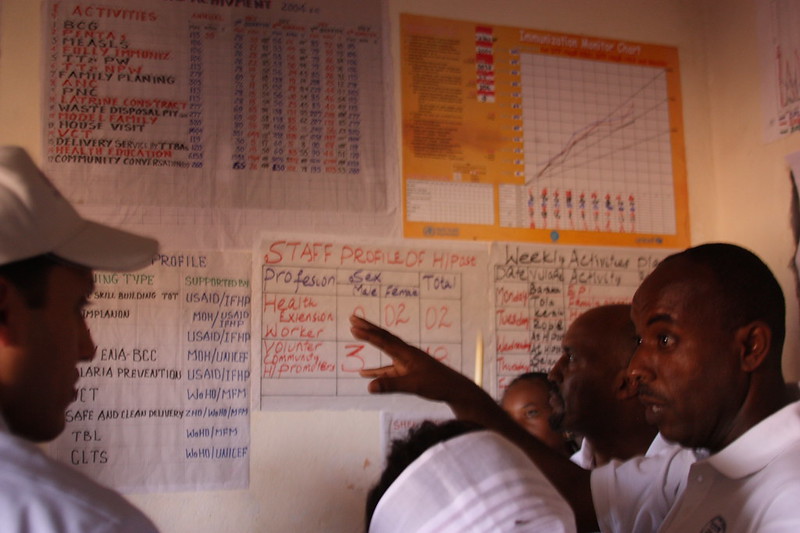December 11, 2012
This is a joint post with Rachel Silverman.
Last week, I attended a conference on South Africa’s national health insurance (NHI), which was hosted in Pretoria by the Human Sciences Research Council (HSRC). A key recurring theme and consensus emerged: South Africa must develop a clearer plan and strategy for the “piloting” phase of its national health insurance.
Some background: In 2011, the government of South Africa committed itself to providing all of its citizens with “a defined package of comprehensive (health) services” through national health insurance. While the details are still up in the air, the government issued a preliminary policy paper which estimated NHI to cost R255 billion (~US$30 billion) per year by 2025, if implemented as planned over a 14-year period.
Beyond the enormous financial implications, the move towards universal, equitable NHI presents many challenges for the South African health delivery system, which is among the most unequal and segmented in the world today. While roughly a fifth of the population receives high-quality, high-cost medical care with private insurance coverage, most South Africans (and the vast majority of black South Africans) rely on free or subsidized services through the public sector that even the government admits “has deteriorated or remained low.” (Of course, the reasons behind this inequity are long, contentious, and closely tied to South Africa’s apartheid history; see here for a useful overview.) Meanwhile, South Africa struggles with a disease burden disproportionate to its upper-middle income status, including a “quadruple burden” of concurrent epidemics: poverty-related illness, non-communicable diseases, HIV/AIDS (among the worst in the world), and violence and injuries.
Within this context, the moral case for NHI is unimpeachable, but the logistics of its implementation are daunting – hence the 14-year roll-out schedule.
As a first step, in April 2012 the Ministry of Health announced the selection of 11 districts (of 54 total) to begin “piloting” NHI, with a mere R20 million (US$2 million) allocated per district. One main objective of the pilots has been to “strengthen performance of the public health system in readiness for the full NHI roll-out” and to “strengthen [the] district health system” in order to be ready for NHI by improving health facility management, human resource planning, and infrastructure quality, among other components. Amid concern that districts lack sufficient local capacity to absorb NHI, this focus seems reasonable. That said, these activities might be more accurately characterized as prerequisites to NHI rather than an NHI pilot.
But while the “health systems first” strategy is a sound approach, I’m concerned that the piloting phase has gone forward without a clear plan to inform the NHI roll-out, and thus might represent a missed opportunity for the South African government. During my conversations with a few district staff participating in the NHI pilots, it became apparent that they had received little or no guidance on the content of the pilot, and their roles within it. Aside from limited guidance on “primary health care re-engineering,” which mainly focused on supply-side improvements, the selected 11 districts were free to experiment with few constraints and little oversight.
Pilot districts are now engaging in self-defined experimentation and learning, but the lessons from their experimentation are not being systematically evaluated and shared. Moreover, while this freedom could be empowering under the right circumstances, many district staff did not fully understand what, exactly, there were supposed to pilot under NHI. Perhaps this is unsurprising, as most policy details of NHI are still under discussion – most importantly the size and contents of the benefit package.
This brings up the broader question: What’s in a pilot? That is, what should a pilot aim to achieve, and how? More specifically, how can the pilot stage of this initiative best advance the cause of universal, high quality healthcare for all South Africans?
One approach comes from the keynote speaker at the HSRC conference, Professor Bill Hsiao of Harvard University, who recommended that the government take deliberate and systematic steps to discover what delivery models work, and at what cost. After first articulating a clear set of questions, the government can use systematic experimentation to arrive at answers best suited to the South African context. To take charge of this process, Hsiao recommends that the government establish a new agency to design, monitor, and evaluate the pilot districts, and to facilitate systematic and deliberate learning between them, and between local and national levels. The proposed agency could help districts to identify a feasible NHI design by tweaking a range of policy variables, including the eligible population, benefit package, financing, regulations, payment methods and rates, and governance – all key design specifications that are needed for NHI legislation.
The South African government can also learn much by absorbing the lessons from international experimentation with social health insurance, including in Taiwan and the United States. As Professor Rachel Lu noted at the HSRC conference, Taiwan, for example, adopted NHI in 1995 and has constantly experimented with vexing questions of how to pay providers and deliver health-care. That experimentation was enabled and facilitated by institutional support and leadership of Taiwan’s Bureau of NHI. Similarly, in the United States, the Center for Medicare and Medicaid Services has developed an Innovation Center to address rising health-care costs. With a budget of $10 billion over 10 years, the Innovation Center is mandated to systematically explore a range of system-wide policy and management interventions, such as accountable care organizations, medical homes, and many others. Institutionalized (and structured) innovation of this sort offers many benefits, particularly the opportunity to support iterative innovation and scale-up successful programs country-wide.
Moving forward, Minister of Health Aaron Motsoaledi will need to re-assess the pilot strategy, and I hope he starts from the fundamental question: what is South Africa piloting – beside re-engineering primary care – and why? How can the pilot phase and each pilot district best support the implementation of a nation-wide social health insurance scheme? As the National Treasury seems to have already allocated 1 billion rand (~US$113 million) for the pilots alone, the Ministry should look carefully at Hsiao’s recommendations and international experience. With careful planning and strategic thinking, the Minister can ensure that the NHI pilots become a powerful tool to shape policies that are appropriate and optimal for the variety of South African contexts. Good luck!
Disclaimer
CGD blog posts reflect the views of the authors, drawing on prior research and experience in their areas of expertise. CGD is a nonpartisan, independent organization and does not take institutional positions.





